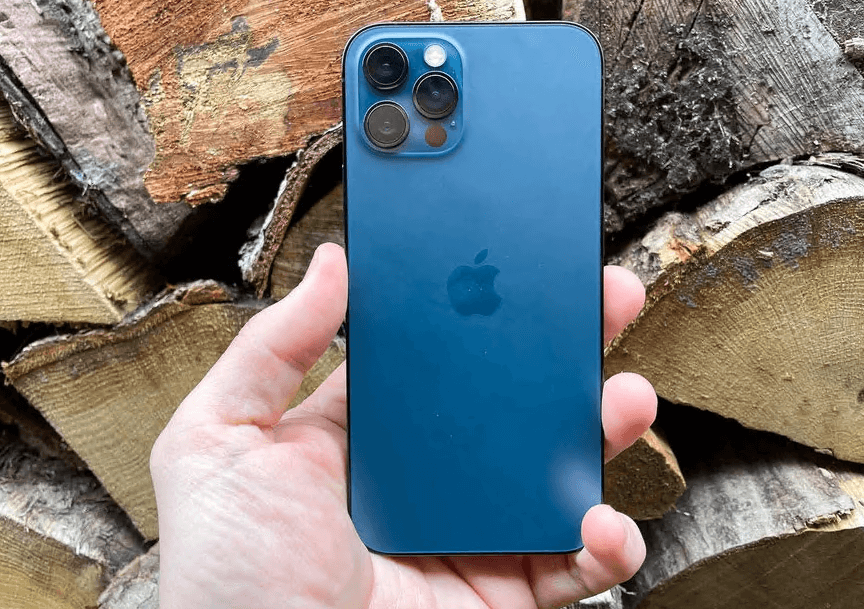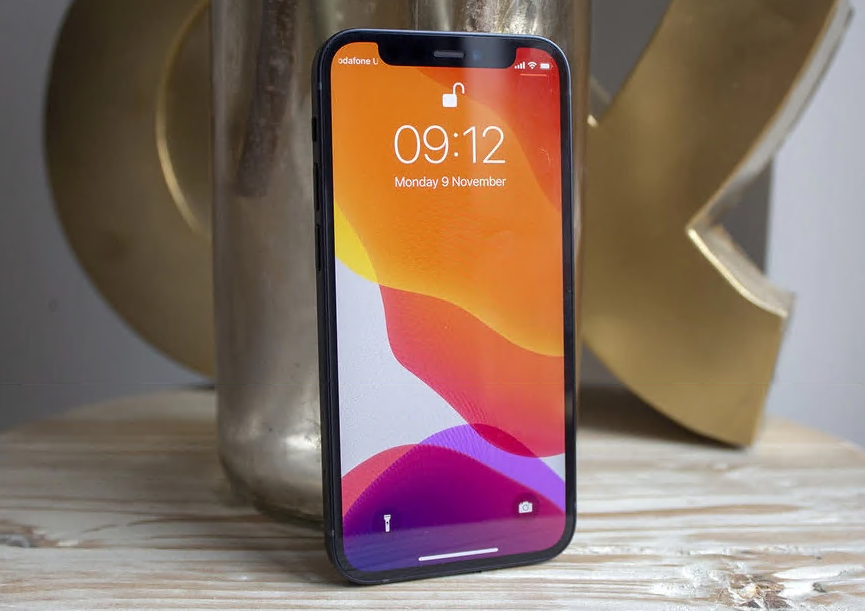
Apple announced four new iPhones in 2020, with the iPhone 12 sitting pretty in the middle as the everyday model, replacing the iPhone 12 all looking to appeal to a wide audience.
By trying to appeal to everyone though, has Apple created a phone that actually doesn't work for anyone? We've been using the new iPhone 12 to find out.
New shiny design
- 146.7 x 71.5 x 7.4mm, 164g
- Black, white, blue, green, red colours
- New squarer design
- IP68 protection
This year brings a new design to the Apple iPhone that is more akin to the current iPad Pro and iPad Air design, or if you want to go back further in Apple's design history, the iPhone 4. The curves have gone and now everything sits within a thin coloured aluminium band with a glass rear and nano-ceramic crystal front covering called Ceramic Shielding. It's designed to be tougher than previous glass treatments to help fend off the scratches and keep your iPhone looking its best through the years of ownership.

Unlike the iPhone 4 that only came in black or white, the iPhone 12 gets five colours - black, white, green (which is more a mint green), blue, and (Product) Red. The colours are striking, but certainly not as fun as the iPhone XR or iPhone 11 - there's no yellow for example. The Blue, which we've got for review, is probably best described as a royal blue, but indoors, under regular lights soon looks like a dark blue. Unlike the frosted iPhone 12 Pro rear, it's also a fingerprint magnet, so it's going to need regular cleaning unless you plan to put it in a case.
We would have liked the screws to match the colour of the casing, and more colour options, but there's little to complain about.
Like the iPhone 11, the iPhone 12 still features a 6.1-inch display, now improved, with the usual array of power and volume buttons down the sides. Yes, it's still got a Lightning connector on the bottom, and you also get wireless charging support too.
The iPhone 12's design works, it's comfortable in the hand and the new design looks smart, a welcome progression from previous design we've had for a few years. It is essentially the same as the iPhone 12 Pro, but with different materials and finishes.
Tougher OLED display
- 6.1-inch Super Retina XDR OLED display
- 2532 x 1170-pixel, 460ppi
- True Tone
- Still has the notch
Along with the new design comes a new display for this level of device, with the iPhone 12 now getting Apple's Super Retina XDR OLED display over the LCD display found in the iPhone 11.
It's virtually the same screen tech as found in the iPhone 12 Pro and the shift to OLED over LCD perhaps accounts for the shift in price for this device over the previous generation. Apple has ditched LCD altogether, with even the new iPhone 12 mini getting an OLED display and that's likely to bring parity across the range both in terms of performance and to support the Dolby Vision certification. The new display is brighter and more impactful than the iPhone 11, so we feel that's a great move, even if this phone costs more.

Having used the iPhone 11 Pro over the last 12 months, it's a great screen both indoors and out that has no problem making everything from iOS 14 to games to movies and more sing. It's especially good when it comes to viewing your photographs.
And this year it's protected with a new material that Apple calls Ceramic Shielding. It's tougher than previous outings, but still prone to fingerprints and scratches.
Superfast 5G
- Auto 5G mode means only uses 5G when needed
- Works with all 5G networks
This year's iPhones all come with 5G as standard and that applies to the iPhone 12 too - there isn't a 4G-only version. However, even if you have 5G coverage, the chances are that the iPhone will try and use 4G whenever possible to try and save battery life, thanks to a feature called Auto 5G. It tries to work out when you need 5G and when you don't - like when the screen is off - and therefore limit how and when you use it. Purists will be happy to know that you can turn it off if you must have that 5G all the time, although it's unlikely you'll ever do that unless you find your phone sticking to 4G when you want it on the faster networks.
When you can find it 5G delivers blisteringly fast speeds. We were able to achieve up to 260Mbps downloads in our tests, although it's worth noting we had to drive 30 minutes to find a 5G connection. What does that mean in real life? A 400MB file downloaded in 15 seconds. Crystal clear FaceTime calls, and an array of other fast access times to games, movies, or other such things.
It certainly feels like the future and will come into its own over the next couple of years as the networks get better, and we start venturing out into the world again. The catch is that while the networks continue to roll out their 5G efforts, you'll more than likely be using 4G, possibly still when Apple announces its 2021 models.
Tech specs and battery life
- A14 Bionic processor
- 64GB, 128GB, 256GB storage sizes
- Wireless charging support
The iPhone 12 might be junior to the iPhone 12 Pro models, but that doesn't mean Apple has given it any less of a processor. It gets the A14 Bionic processor, as do all the other iPhone 12 models, which brings more power, greater efficiencies and boosts the performance over older iPhone models.
As you would expect, you get buttery smooth menu swiping and games and apps will load faster than previous iPhone models, but you'll also get camera features previously unavailable on an iPhone in this position.

Apple doesn't declare the capacities of its battery, instead saying that performance on the iPhone 12 will match that of the iPhone 12 Pro and it will get you through the day without any concerns. There are things that will push the battery harder - 5G usage, Dolby Vision movie shooting, or playing the latest hardcore games - but we've not found these changes to cause concerning battery drain.
There's now no charger in the box - just the cable - and you'll need to plug this into a USB-C charger. That might be a socket on your MacBook, or indeed your MacBook or iPad Pro charger, although the phone itself still carries the Lightning connector, so if you have an old charger, you'll still be able to use that.
There's support for fast charging at 20W, although you'll have to buy the charger for that, as we've said.

The iPhone 12 also supports wireless charging, and you'll either need a Qi wireless charging pad or a new accessory Apple has launched called MagSafe. It's a wireless charger with a ring of magnets around it that allows the charger to snap on to the back of the iPhone 12, just as you'd charge the Apple Watch. The centre of the MagSafe charger is padded, so it won't scratch your phone, and it's a convenient solution to keeping the phone and the wireless charger together, rather than having to position it in the right place on a pad.
Wireless charging has the obvious advantage of letting you charge your phone while you're using the Lightning connector for something else, like wired headphones, but obviously, you'll have to invest in the system. If you want to use a case and MagSafe charging, you'll have to have a case that's compatible to make sure the system continues to work.
Master of photography
- Dual cameras system:
- Main: 12MP, f/1.6, OIS
- Ultra-wide: 12MP, f/2.4
- Night mode, Smart HDR 3, Deep Fusion, Portrait mode
The biggest difference between the iPhone 12 and the iPhone 12 Pro is on the photography side of things. The iPhone 12 doesn't come with the 2x telephoto lens nor the LiDAR scanner to help auto-focusing that the Pro models get. That shouldn't limit your photography too much, but if you use zoom a lot, you might want to consider the 12 Pro instead. The zoom on the iPhone is limited to 5x digital.
The main camera has a 12-megapixel sensor, with Apple (like Google on the Pixel phones), avoiding the temptation to move to a higher resolution sensor. We feel that's the right decision because bumping the megapixels doesn't immediately equate to better images. Here Apple has paired the sensor with an f/1.6 lens, so it's a slightly wider aperture than the iPhone 11 that camera before it, boosting the potential for low-light performance, while also using optical image stabilisation to reduce handshake.
The iPhone 12 pairs this great main camera with a 12-megapixel f/2.4 ultra-wide camera, allowing the fun that comes from having a wider angle, especially good for landscapes where you want to add that sense of expansiveness. There is a 12-megapixel selfie camera on the front of the phone.

The great thing is that you can take advantage of all the tech from across the camera system on any of the lenses - portrait mode, night mode, HDR, works on the front and rear cameras. The combination of all this tech are pictures that are impressive time and time again. Colours are strong, images crisp, and although the Portrait mode algorithms can still be a little aggressive at times, considerably better than they've previously been, although edge detection isn't the best out there. And switching between the two cameras isn't noticeable. Everything matches. It's one seamless experience.
Night Mode, added to Apple's arsenal in 2019, is like night and day when it comes to low-light photography, and we're equally impressed with the iPhone 12's HDR photography capabilities, all the while not really bothering you with dozens of settings to master. Point, shoot, snap, and enjoy seems to be Apple's mantra here and it works.
The same can be said for recording video. You now get Dolby Vision recording up to 4K 30fps (it's up to 60fps on 12 Pro) and that means your videos have an almost hyper-real quality to them, popping out of the screen. Apple has been strong on video capture for many generations of iPhone and the addition of HDR, with the fun of that Dolby certification, is going to continue that trend.
Verdict
Like the iPhone 11 before it, the iPhone 12 offers many of the important things that you want from the iPhone: a decent camera, 5G, great screen, fast processor, and leaves out many of the "nice to haves" like 60fps video recording, a telephoto lens, or the LiDAR scanner.
Look closely and there are differences, but for that group of people that want a new iPhone, but just can't justify the price of the iPhone 12 Pro range, this is a great choice without having to feel like you are settling for second best.



